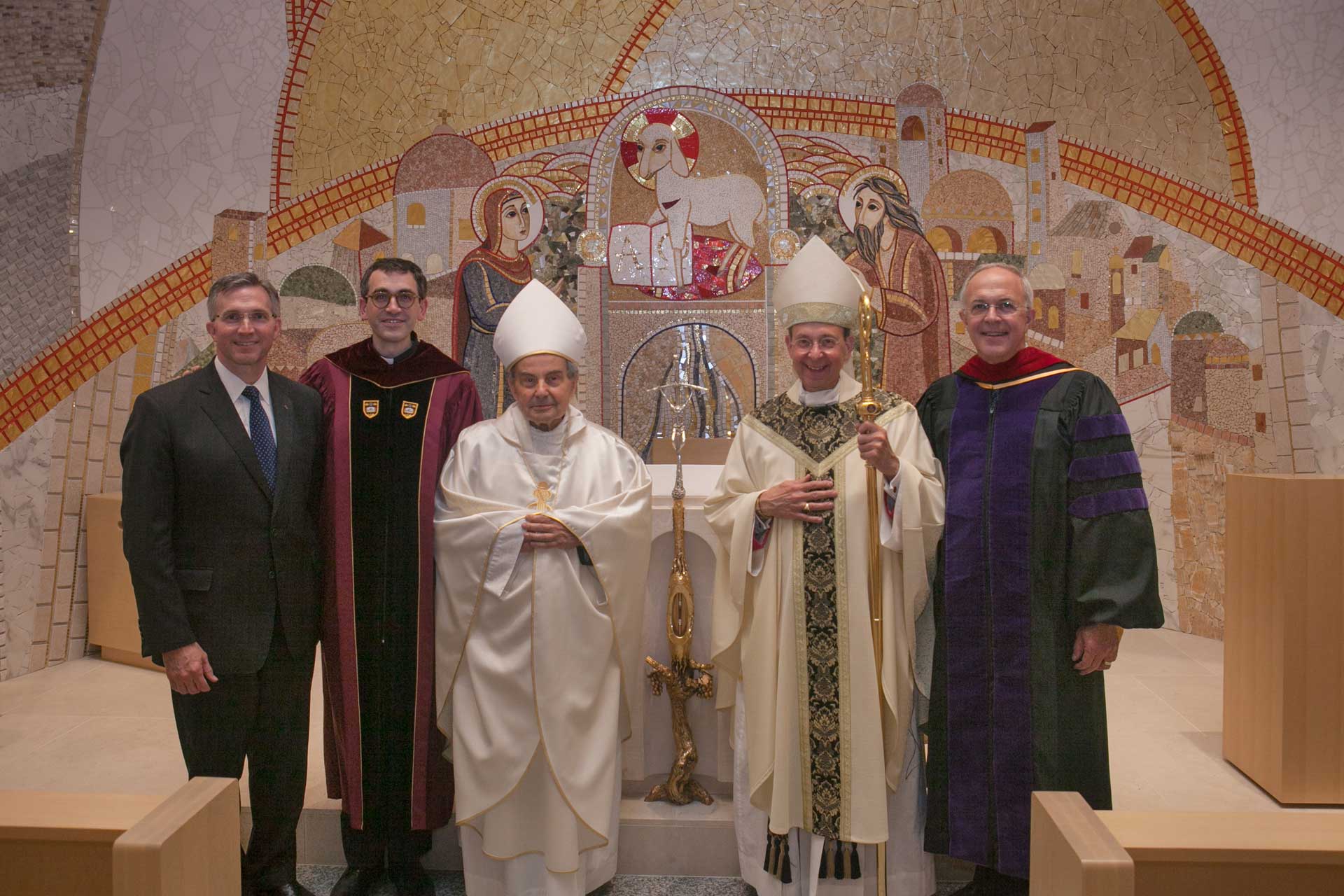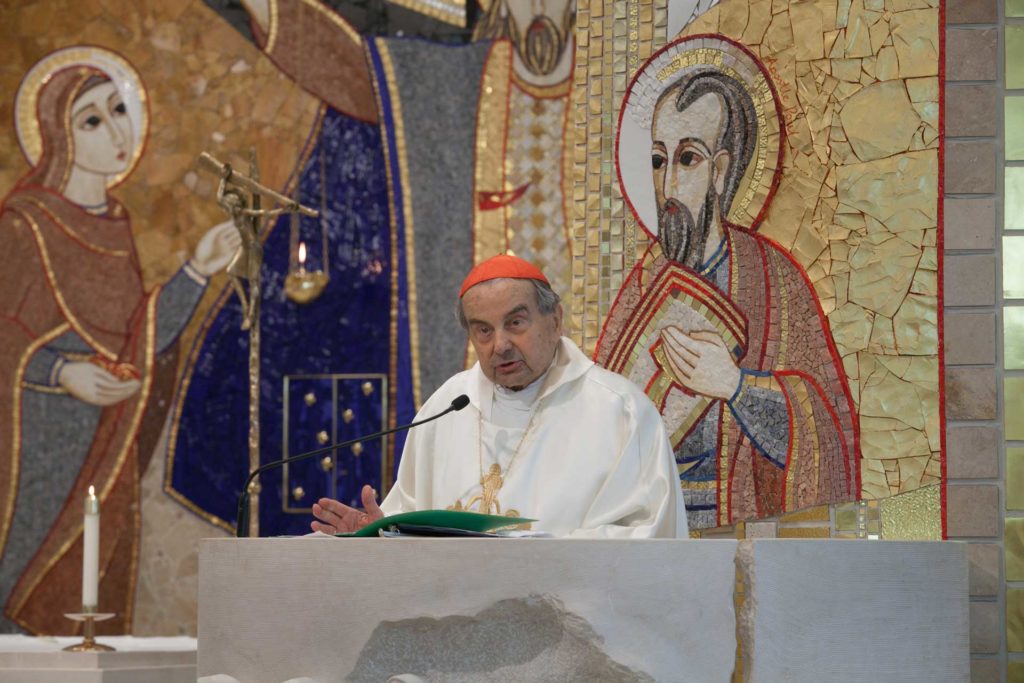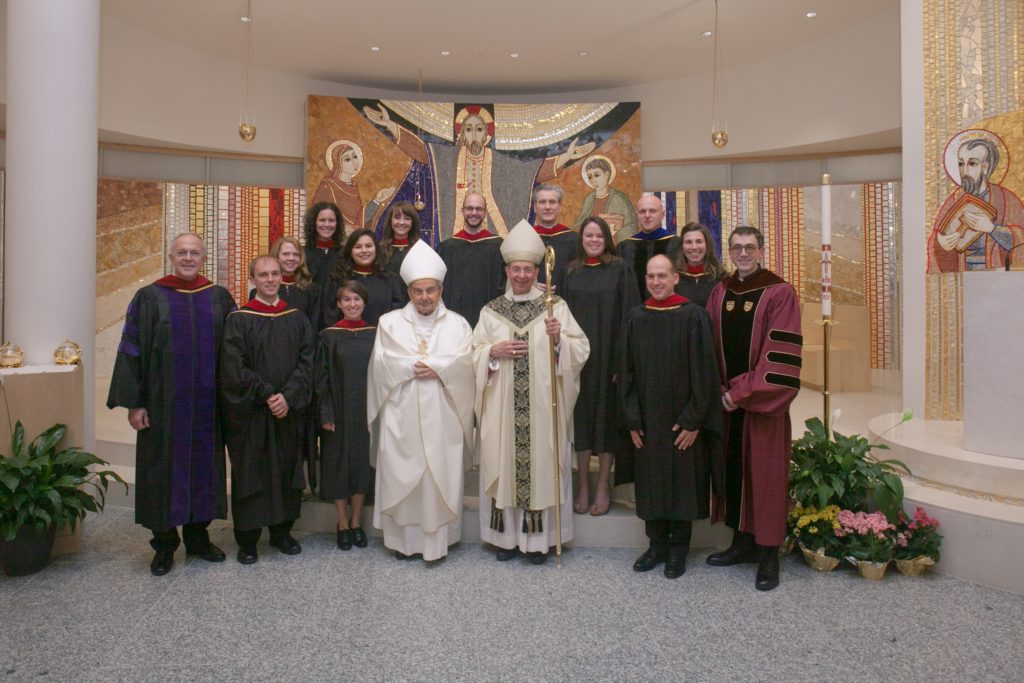Cardinal Carlo Caffarra,
Archbishop Emeritus of Bologna
Graduation Address to the Pontifical John Paul II Institute
May 10, 2016
I am deeply grateful to my dear friend Carl Anderson, Supreme Knight of the Knights of Columbus, for inviting me to visit the John Paul II Institute for a few days.
I address my respectful greetings to the Metropolitan Archbishop of Baltimore, His Excellency William Lori, and to all of the faculty members, who are well known for their dedication to the Institute and their acknowledged academic competence.
But especially to you, the new graduates, I address my affectionate greetings: today a great task awaits you in the Church and in your great country. You know very well the influence for good and evil that your nation exerts throughout the world.
I will divide my reflection into three parts. In the first I will speak about the birth of the Institute, about its DNA. In the second I will speak about some of the major challenges that the proclamation of the Gospel of Marriage must confront in the West. In the third I will offer some considerations about the future of the Institute.
1
Memory
As everyone knows, the Institute was intended by Saint John Paul the Second as a response to a request made by the bishops present at the Ordinary Synod on the Family that took place in October of 1980. The bishops requested the foundation of a center for scientific study. John Paul II welcomed this request and founded the Institute and commissioned me to carry out his decision.
Obviously my first concern was to understand correctly the intention, the plan of the Holy Father: to know what he was really thinking about the Institute. I met with John Paul II very frequently and I can therefore summarize his thought in this regard.
a) The research was supposed to have a rigorously scientific character. In order to understand what John Paul II meant by this, we must “purify” our concept of science and remove from it the connotations introduced by scientism. For the Pontiff, scientific research meant that our research, our studies on marriage and the family had to go to the foundation, or as he preferred to say in biblical language, to the beginning. The idea that robust doctrine had no fundamental importance for pastoral ministry was totally foreign to the Pope. On the contrary, he did not think that pastoral care was possible unless it “spoke the truth” of doctrine (“veritatem autem facientes in caritate” Eph 4:15). In short: there is no separation between doctrine and pastoral work.

b) Therefore research into the foundation of marriage and the family, a return to the Beginning, was the task of the Institute. The two main characteristics of the Institute follow from this: a strong commitment in the field of anthropology, and Christocentric thought. I would like to dwell for a moment on these two characteristics. Let us enter into the heart of the Institute.
- The Pope was profoundly convinced that the crisis of marriage and the family was basically an anthropological crisis: the human person had lost awareness of himself, of the truth of his being a person, so that he no longer understood the truth of marriage; not only in the intellectual sense, but in the existential sense.
Marriage is the privileged path to the human being; in order to reconstruct the meaning of the family, it is necessary to reconstruct what it means to be human: the humanum.
- This return to the Beginning brings to light the relation that keeps together Christ, the human person, and marriage. This relationship is instituted by the Sacrament of Matrimony.
- The Pope was profoundly convinced that the crisis of marriage and the family was basically an anthropological crisis: the human person had lost awareness of himself, of the truth of his being a person, so that he no longer understood the truth of marriage; not only in the intellectual sense, but in the existential sense.
c) John Paul II establishes the relation between marriage and the human person by means of the philosophy and the theology of the body. This is the most precious heritage that he entrusted to the Institute. The Church lacked this theology and philosophy, and she still has not fully assimilated the wealth of insights contained in these teachings.
d) The Pope thinks that there is a knot that ties all the “strings” together, a crossroads where all the previous insights meet: the Encyclical Humanae Vitae. The Apostolic Constitution Magnum matrimonii sacramentum, the document which founded the Institute canonically, assigns as a specific task of the Institute the reflection on this Encyclical. This is the great theme of the truth about human procreation.
e) The foundation is based on the certainty that pastoral work without doctrine is blind, and therefore constantly in danger of succumbing to the tyranny of worldliness. I must dwell for a moment on this point, which is also dramatically relevant today.
When I say “doctrine” I do not mean primarily the moral norms concerning marriage, which pastoral practice then seeks to apply. Nor do I mean what the Church teaches about the nature of marriage as though it were an ideal to be reached. I do not intend to demonstrate now the consequences that this view leads to. I will return to this point later.
Reflection on a scientific and academic level, which John Paul II assigned to the Institute as its specific task, aims to discover the truth about marriage and the family. It deals with the structure of the human person, with his nature insofar as it is dynamically oriented toward his fulfillment in Christ in the form of charitas coniugalis: conjugal charity.
It is a truth that has been entrusted to freedom, because it is a truth to be carried out (veritas facienda): not as a law that has been imposed from outside (exterius data), but as an intrinsic law (lex indita).
Let me summarize. The Institute’s DNA, if we can say that, is therefore as follows: to discover the truth about marriage and the family, on the basis of an adequate anthropology, in order to help the husband and the wife to live fully their conjugal vocation.
2
Confronting the Challenges of Western Modernity
The decision and the project of John Paul II have proved in recent years to be truly prophetic. Indeed we have witnessed a real de-construction of marriage. The current situation of marriage can be described with the verse by the Latin poet Virgil about a shipwreck: rari nantes in gurgite vasto: “rare swimmers in a vast whirlpool.” Western civilization still has all sorts of marital categories, but the building no longer exists. These categories no longer have an unambiguous meaning. For example, who is the mother? The woman who supplies the ovum, or the one who carries the embryo in her womb, or the one who pays the rent for the womb? Mater semper certa, “The mother is always certain,” the Roman legal scholars used to say; pater semper incertus, “The father is always uncertain.” Now that is no longer true.
In this situation of complete uncertainty, the only remaining option was to turn to the public powers. To governments is entrusted the very definition of marriage: of fatherhood, motherhood, and what it means to be a spouse.

In what sense were the decision and project of John Paul II prophetic?
Personally, I think that the deconstruction of marriage resulted from a de-biologized concept of the human person. That is to say: through a cultural process that took centuries, a view of the human being developed that excluded the body from the constitution of the human person: according to this view, a person has a body but is not his body. I cannot trace now this cultural process. I simply want to recall an extremely important fact.
The Church was not able to respond to this process. Consider the following facts. The major thesis of Thomas Aquinas about the substantial unity of the human person never turned out to be convincing in Western Christian thought. Natural law theory was unable to safeguard the marvelous theoretical balance between bios and logos that we observe in Thomas’ writings. The major crisis that exploded with Humanae Vitae made this situation of incapacity of the Church to respond to the cultural processes quite clear.
When John Paul II gave the Institute the difficult job of reconstructing a major theology and philosophy of the body, in the context of constructing an adequate anthropology, he had identified in this emergency the way to reconstruct a new, truly human and Christian vision of marriage. The fact that along with the foundation of the Institute the Pope also reformed the Pontifical Council for the Family indicated that intellectual engagement was not enough: a truly pastoral change was also necessary.
Several Synod Fathers noted in the Synods of 2014 and 2015 the almost complete absence of the magisterial teaching of John Paul II from the two Synods. The fact that his catecheses on human love were not taken as the basis for pastoral practice concerning marriage was a main reason for the serious difficulties with the Synods. The Post-Synodal Exhortation Amoris laetitia sought to correct this lacuna.
I have mentioned only one aspect of the prophetic vision. There are others that I cannot mention now, for lack of time. And so we can discuss the third and final point of my reflection.
3
What Future?
What task awaits the Institute now? Before I answer this question, allow me, dear friends, to preface my remarks with something that I think is very important.
One of the most serious dangers that the Church must guard against in her commitment to proclaiming the Gospel is the separation of pastoral practice from the doctrine of the faith. This is a very grave danger.
The alternative to a Church with doctrine is not a more pastoral Church, but an arbitrary Church enslaved to the spirit of the age: praxis sine theoria coecus in via, the Medieval scholars used to say: “Practice without theory is a blind man on the road.” This danger is serious, and if it is not overcome it causes serious harm to the Church. For at least two reasons. The first is that, since Sacred Doctrine is nothing other than Divine Revelation about God’s plan for mankind, if the Church’s mission is not rooted in it, what does the Church have to say to mankind? The second reason is that when the Church does not guard herself from this danger, she runs the risk of being inspired by the central dogma of relativism: with regard to the worship that we owe to God and the care that we owe to our fellow men, it does not matter what I think about God and about man. The quaestio de veritate, the question of truth becomes secondary.
One of the reasons most frequently heard for justifying this separation is that doctrine is abstract while pastoral practice has to do with the concrete realities of life. This statement is ultimately a truism. It is clear that doctrine is abstract: it is so by its very nature. Just as practice… is practical. But life, Christian life needs both. The foundation of Christian life is faith, which formally is an act of reason; it is assent to revealed Truth. But revealed Truth is a veritas salutaris, a saving truth. In short: praxis sine theoria coecus in via, theoria sine praxi currus sine axi, as they used to say during the Middle Ages: “Practice without theory is a blind man on the road; theory without practice is a chariot with no axle.”

Only this vision allows everyone in the Church to carry out his mission. The Magisterium of the Church teaches doctrine; theology deepens it; confessors and spiritual fathers help the person to live it, to realize it in his life. The pulpit and the chair [cathedra] must remain distinct.
Please excuse me for this long preface. I am deeply convinced that the first challenge that the Institute must confront in the future is to preserve its qualifications as a scientific academic institute. I would dare to say: sit ut est aut non sit. Let it be as it is, or let it not be at all.
Within this intellectual commitment, this work of thinking, what are the principal needs that the Institute is called to address?
The first need is reflection on the anthropological basis of marriage, its natural structure; I like to call it marriage in the order of creation.
John Paul II was right when he put at the foundation of the Institute the idea that there is a sort of reciprocal in-dwelling between anthropological reflection and reflection on marriage. The truth about man is the way to know the truth about marriage; the truth about marriage is the way to know the truth about man. Reflection on marriage is the crossroads where all these issues meet: the truth of love and sexuality, the truth of freedom, the truth of the genealogy of the person, and of human society.
The second need is theological reflection on the sacramental character of marriage. As I demonstrated elsewhere, post-Tridentine theology lost the awareness of sacramental ontology, of the real transformation produced by the sacrament in the persons of the spouses [res et sacramentum]. A theology of the conjugal Covenant was replaced by the notion of a contract, as a human act by which two persons commit to each other. The sacramental character consisted in the assurance of divine graces given so as to fulfill the contract. Consequently the words of Jesus, “What God has joined together, let not man put asunder,” lost all their realistic force. Absolute indissolubility, once the sacrament was perfected [= a ratified, consummated marriage], became essentially indefensible.
The third need is reflection on the genealogy of the person insofar as it is inscribed in the biology of generation. The anthropological foundation of the Encyclical Humanae Vitae is a “constitutional duty”, if I can say that, inasmuch as this task was entrusted to us by the Apostolic Constitution Magnum matrimonii sacramentum. Today this task has logically been broadened because of the challenge of artificial procreation.
The fourth and final need is to reestablish the public relevance of marriage and its pertinence to the common good. This is a major problem of political philosophy of the doctrine of the State.
I have finished. I apologize for the length of these reflections. The Institute’s task today is a great one. I knew how much importance the Pope of the Family, Saint John Paul II, assigned to the Institute. I am sure that his intercession will not fail us. Dixi.
Cardinal Carlo Caffarra (1938-2017) was ordained a priest in 1961 for the Diocese of Fidenza. He held a doctorate in canon law from the Pontifical Gregorian University and specialized in his scholarship and teaching in bioethics and the theology of marriage. He was appointed by Pope John Paul II as founding President of the Pontifical John Paul II Institute for Studies on Marriage and Family, and he served in this position from 1981 to 1995, when he was named archbishop of Ferrara-Comacchio. He served as archbishop of Bologna from 2004 to 2015 and was created a cardinal by Pope Benedict XVI in 2006.